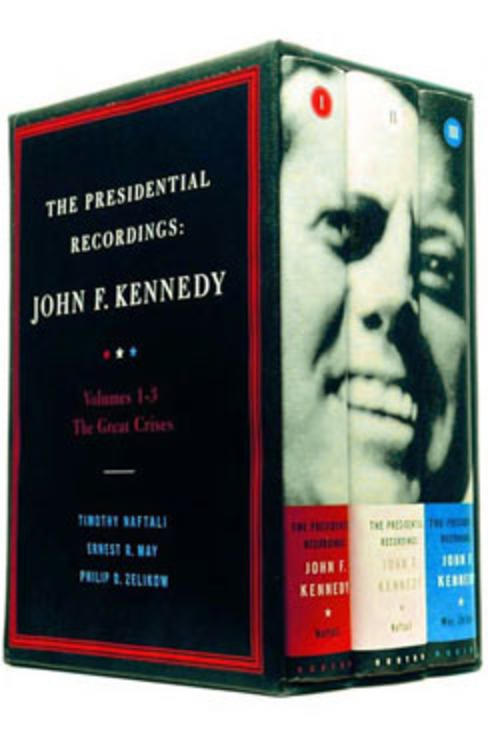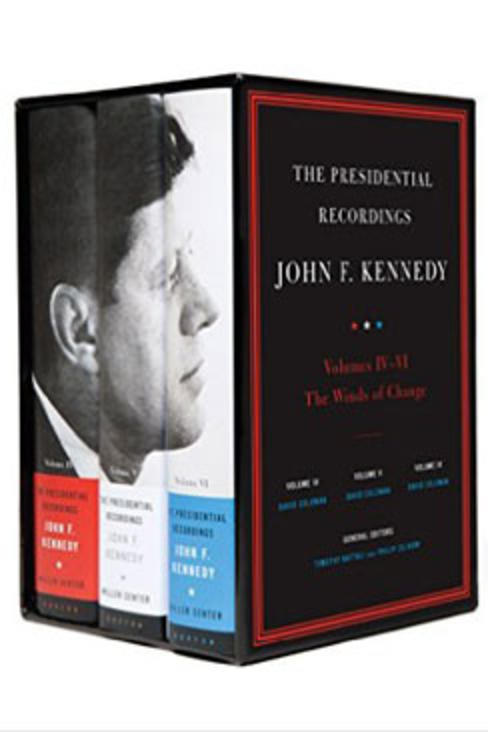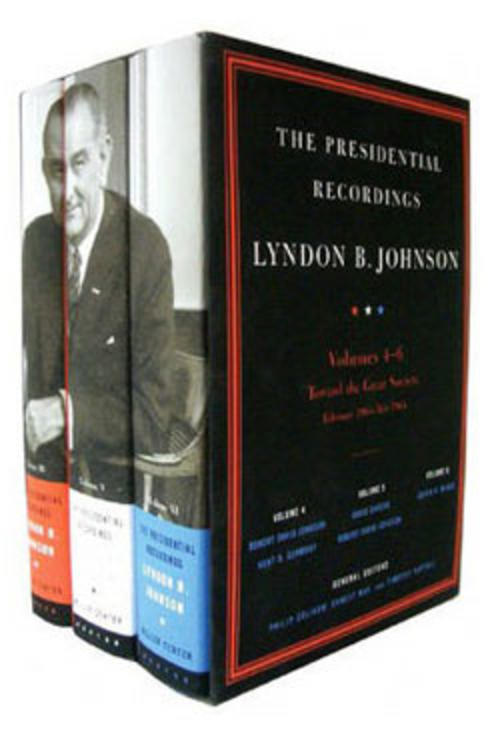About the Presidential Recordings Program
Overview
Between 1940 and 1973, six consecutive American presidents secretly taped thousands of their meetings and telephone conversations. These exchanges took place in the White House and in the Executive Office Building, at Camp David and at the LBJ Ranch, and during travel. From Franklin D. Roosevelt, whose infrequent recordings yielded only 8 hours of taped material, to Richard M. Nixon, whose voice-activated system captured 3,400 hours of discussion, the White House tapes constitute a unique and irreplaceable source for the study of U.S. history and American government.
The Miller Center established the Presidential Recordings Program (PRP) in 1998 to make these once-secret White House tapes accessible to citizens, journalists, policymakers, scholars, students, teachers—indeed to all who have an interest or investment in the workings of American democracy. PRP brings together scholars and students in a collaborative effort to transcribe, annotate, and interpret these extraordinary resources. Through the production of transcripts and original research, PRP eagerly shares theses invaluable materials so that the past may speak to the present with greater historical perspective.
This effort has benefited greatly from the assistance of several public and private partners. The National Historical Publications and Records Commission has provided generous funding for the program’s efforts and has been a vital source of support since its founding. The presidential libraries—the official repositories for the presidential recordings—and the National Security Archive have also provided valuable assistance, helping PRP to acquire the raw materials necessary for this work.
Project Methods
Consistent with guidelines established by the Modern Language Association, PRP seeks to ensure the accuracy of its transcripts, the adequacy and propriety of its editorial principles and practice, and the consistency and explicitness of its methods.[1] The program also adheres to the standards adopted by the Association for Documentary Editing on matters concerning transcription, digitization, selection, annotation, and access.[2]
PRP employs a team-based approach to transcription. While talented student interns and researchers generate first-draft transcripts and validate their digital coding, trained editors and professional historians perform the bulk of the work. All scholars associated with the program have conducted extensive research on the period covered by the tapes and on many of the central themes of the meetings and conversations.
Nevertheless, no one historian can claim expertise on all of the issues discussed on the tapes, nor can a single scholar reliably transcribe a conversation exclusively on his or her own. Physical limitations complicate the task of accurate transcription, as the majority of the tapes are, at best, scratchy. Speakers often talk simultaneously, and their voices and accents can be difficult to distinguish. Room noise, coughs, laughter, and other static frequently drown out words. At times, and especially during meetings, speaker identification becomes the transcriber’s greatest challenge. To ensure the accuracy of its work, PRP requires the participation of multiple scholars and editors to prepare and critique all transcripts of meeting and telephone conversations, refining the transcripts through progressive renderings of “A,” “B,” “C,” and “D” versions. Following their review by the copy editor, the transcripts proceed to the general editor for final review, after which the press takes delivery of the documents for publication.
The pursuit of transcript fidelity involves the practice of turning transcribed words into readable prose. Since very few people speak in complete, grammatically correct sentences, and since virtually no participant in the recordings ever speaks from a prepared text, the transcriber must impose editorial judgment by inserting punctuation and stylistic order upon these conversations, incorporating elements such as paragraph breaks, commas, semicolons, em dashes, and periods. The copy editor contributes greatly to this process, further refining the literary presentation of the transcripts.
PRP strives to make the recordings comprehensible, providing the best possible sense of the actual dialogue as the participants themselves understood it. To that end, the program has long implemented “normalized transcription,” which aims to convey the substance and intention of the speakers, rather than “diplomatic transcription,” which seeks to preserve every utterance and accidental mispronunciation. It has embraced the normalized approach for two reasons: first, to ensure readability and accessibility; and second, to complement, not supplant, the original recording as the document of record. PRP therefore publishes the transcripts alongside their corresponding tapes so that the user may experience and compare the two simultaneously. By offering this facility, PRP intends for users to enjoy a previously unavailable level of accessibility to both text and audio.
At the same time, PRP remains acutely conscious of its responsibility to present the most accurate and complete account of the recordings as possible. As a result, scholars render indecipherable passages as “unclear.” These passages may be as short as a single syllable or as long as several sentences, and may be obscured due to overlapping voices, soft-spoken voices, the position of microphones, tape degradation, or some combination of these factors. Currently, four categories of unclear passages exist in PRP’s published transcripts, constituting the beginning of a sentence, the entirety of a sentence, a run of several sentences, or a sentence fragment. Likewise, scholars render speakers whom they cannot identify as “unidentified.” While the program makes every effort to avoid the use of “unclear” or “unidentified,” it will employ these renderings if the scholars deem the relevant sounds and participants sufficiently indeterminate. Rather than introduce potential inaccuracies into its work, PRP seeks to err on the side of prudence until such time that, through technical improvements, human means, or some combination of the two, the preponderance of evidence warrants emendations.
Publishing Methods
PRP makes its transcripts accessible via two audience-specific portals, both of which leverage the flexibility of digital technologies. Fully annotated transcripts are available through subscription, according to graduated pricing tiers, from the Presidential Recordings Digital Edition (PRDE). First published in 2014 by Rotunda, the digital imprint of the University of Virginia Press, PRDE comprises a searchable XML database that permits precise discovery for dates, phrases, participants, and topics. PRDE also permits users to browse the conversations through a series of facets or constraints, and allows staff to update or correct transcripts should new information become available.
PRDE incorporates digitized and XML-encoded versions of all PRP transcripts previously published in letterpress editions with W. W. Norton. These include eight volumes of Johnson transcripts (2003–2011) and three volumes of Kennedy transcripts (2001). PRDE also includes born-digital transcript volumes on Nixon’s First Week of Taping, Nixon and Arms Control, and Nixon’s Telephone Tapes: 1971. In addition, it includes transcripts published in conjunction with Ken Hughes’s two books—Chasing Shadows: The Nixon Tapes, the Chennault Affair, and the Origins of Watergate (Virginia, 2014), and Fatal Politics: The Nixon Tapes, the Vietnam War, and the Casualties of Re-election (Virginia, 2015)—and Nicole Hemmer’s Atlantic article on Vice President Spiro Agnew. All transcripts published in conjunction with these interpretive works are available in PRDE free of charge. Later in 2017, PRDE will publish born-digital transcripts of Kennedy telephone and meeting tapes on civil rights.
Other curated selections of PRDE transcripts are available free of charge on the Miller Center’s website. These transcript snippets feature synchronized text + audio exhibits, ideally suited for classroom use and popular consumption. These exhibits also allow for the incorporation of associated materials such as documents, essays, video, and additional audio (e.g., presidential speeches, statements, and press conferences), providing historical context for the White House tapes in a multimedia format.
Preservation Standards
PRP has established a solid archival foundation for its work and continues to enhance its capacity to ensure the long-term sustainability of its products. Tailored to the needs of a modern digital documentary editing project, PRP’s technological infrastructure uses the best software and platforms the program can afford. Its scholars work from digital copies of the recordings made from the Digital Audio Tape (DAT) masters held at the corresponding presidential libraries and encoded in accordance with archival standards and best practices. Each transcriber uses studio-quality headphones and audio software such as Adobe Audition, Audacity, or NCH’s Express Scribe, with the signal boosted by headphone amplifiers when necessary.
PRP’s internal workflow has relied on the Pubman content management system, created by dataformat.com (now Ingénerie Diffusion Multimedia) and used by numerous reference projects, including Cambridge University Press (Cambridge Dictionaries), Oxford University Press (Oxford Bibliographies Online), Princeton University Press (Papers of Thomas Jefferson), and the Papers of Abraham Lincoln. Pubman establishes strict version control for the transcripts and provides redundant backups of the transcript files.
To ensure the long-term compatibility of the data, PRP encodes its transcripts in XML (Extensible Markup Language), using open standards developed by the Text Encoding Initiative (TEI P5). Scholars and editors use oXygen as the preferred XML authoring software. Program staff delivers XML content for these born-digital transcripts to Rotunda, whose staff in turn runs a separate set of transforms to load the content into PRDE.
Using the TEI Tite encoding standards of the Text Encoding Initiative, an experienced vendor converts content from the Norton letterpress volumes to XML format.[3] UVa Press checks the received files for accuracy, then adds the metadata for each recording to power the digital edition. The single-volume XML files are split via XSLT into individual files for loading into PRDE.
UVa Press stores all XML content for PRDE in a version control system (Subversion), with instances on multiple physical servers that are regularly backed up, enabling restoration of the current or any historical state of the data. The MarkLogic code that powers PRDE resides on a development and production server housed in the UVa Data Center, and receives regular back-ups and versioning via MarkLogic's scheduling module.
[1] “Guidelines for Editors of Scholarly Editions,” Modern Language Association, last modified 29 June 2011, accessed 27 February 2017, https://www.mla.org/Resources/Research/Surveys-Reports-and-Other-Documents/Publishing-and-Scholarship/Reports-from-the-MLA-Committee-on-Scholarly-Editions/Guidelines-for-Editors-of-Scholarly-Editions.
[2] “Minimum Standards for Electronic Editions,” Association for Documentary Editing, accessed 27 February 2017, http://www.documentaryediting.org/wordpress/?page_id=508.
[3] See “TEI Tite: A Recommendation for Off-Site Text Encoding,” Perry Trolard, TEI Consortium, accessed 27 February 2017, http://www.tei-c.org/release/doc/tei-p5-exemplars/html/tei_tite.doc.html.




